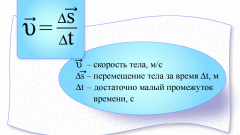Instruction
1
By itself, the specified vector does nothing in terms of the mathematical description of motion, so it is considered in projections on the coordinate axes. This may be one coordinate axis (the beam), two (plane) or three (space). To find the projection, you need to drop perpendiculars from the ends of the vector on the axis.
2
Projection is like a "shadow" of the vector. If the body is moving perpendicular to the considered axis, the projection degenerate to the point and will have a value of zero. When moving parallel to a coordinate axis, the projection coincides with the module of the vector. And when the body moves so that its velocity vector is directed at some angle φ to the x-axis and the projection on the x-axis is cut: V(x)=V•cos(φ), where V is the module of the velocity vector. Projection is positive when the direction of the velocity vector coincides with the positive direction of the coordinate axis, and negative otherwise.
3
Let the motion of a point set to the coordinate equations: x=x(t), y=y(t), z=z(t). Then a function of speed, projected onto the three axes, will have the form, respectively, V(x)=dx/dt=x'(t), V(y)=dy/dt=y'(t), V(z)=dz/dt=z'(t), that is, to find the speed you need to take derivatives. The velocity vector will be expressed by the equation V=V(x)•i+V(y)•j+V(z)•k, where i, j, k are unit vectors of coordinate axes x, y, z. The module speed can be calculated by the formula V=√(V(x)^2+V(y)^2+V(z)^2).
4
Through the guides of the cosines of the velocity vector and unit segments of the axes you can set the direction of the vector, discarding his module. For a point that moves in a plane only two coordinates, x and y. If a body makes a circular motion, the direction of the velocity vector is constantly changing, and the module may remain constant or vary over time.


